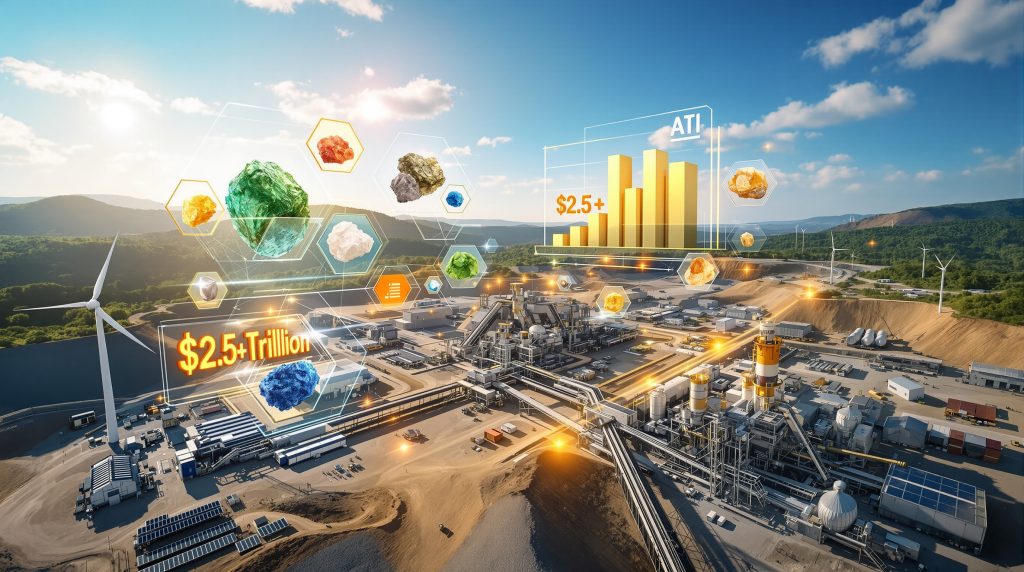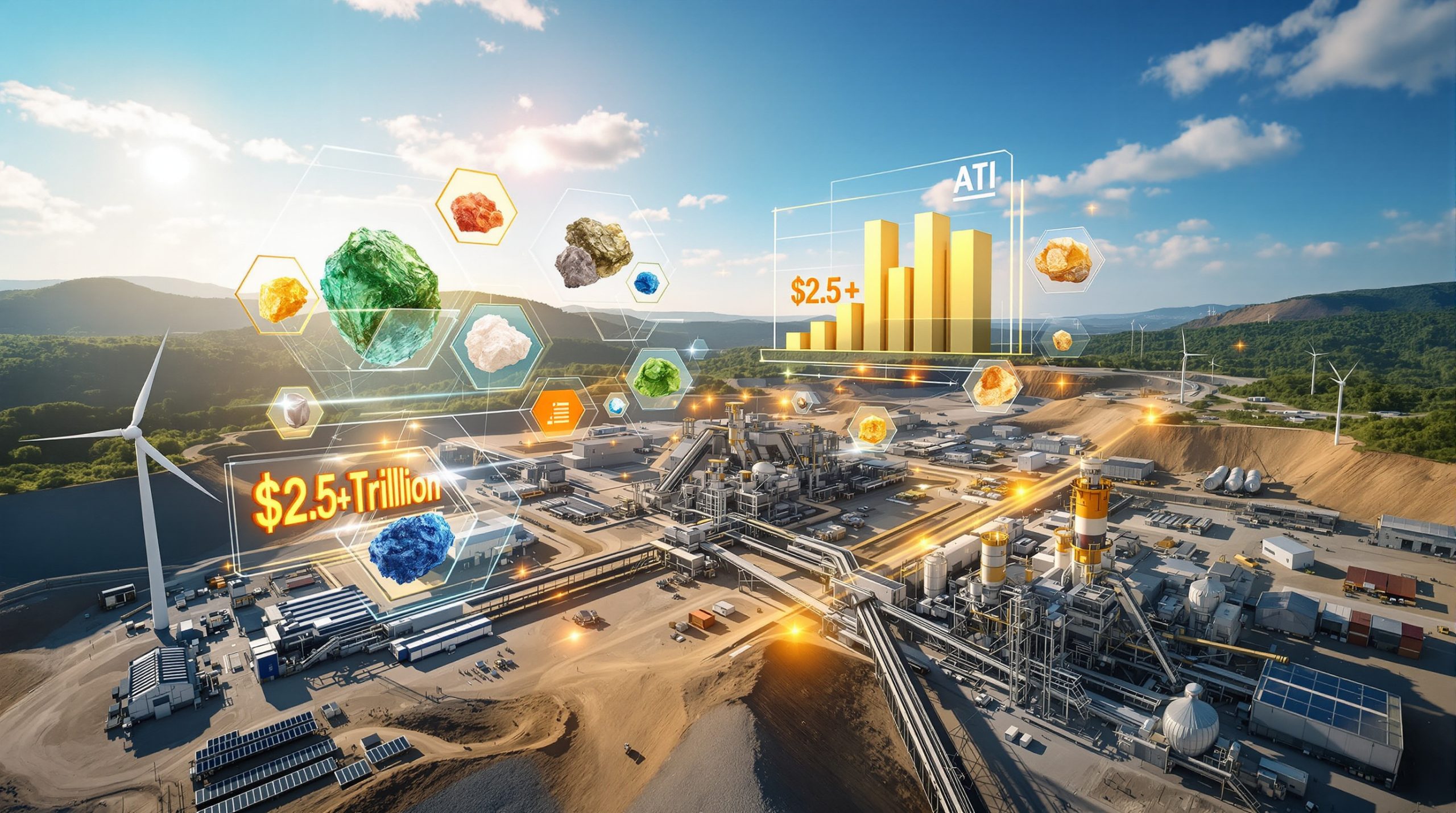The transformation of unlocking value in mine tailings from environmental liabilities into strategic assets represents one of the most significant opportunities in contemporary mining. Mining operations worldwide generate approximately 12.3 cubic kilometers of waste material annually, creating what industry analysts increasingly recognize as the planet's largest untapped mineral inventory. This accumulation represents far more than environmental liability—it constitutes pre-concentrated resources positioned at existing infrastructure sites, fundamentally altering traditional project development economics.
Contemporary mining faces converging pressures that amplify the strategic importance of waste valorisation. Declining ore grades in new discoveries, extended permitting timelines, and capital market hesitation toward greenfield exploration create compelling incentives for surface-accessible mineral recovery. Advanced mining waste management solutions now enable economic extraction from materials previously considered worthless, transforming legacy liabilities into revenue-generating assets.
The Economics of Tailings Valorisation: From Liability to Revenue Stream
Global mining operations have accumulated approximately 282 billion tonnes of historical waste across an estimated 8,500 facilities worldwide. This material volume, equivalent to a cube measuring 6 kilometres on each side, contains an estimated $2.5 trillion in recoverable value based on current commodity pricing assumptions.
The economic calculation assumes specific commodity valuations: copper at $8,000 per tonne, gold at $2,000 per ounce, iron oxide at $40 per tonne, zinc at $2,400 per tonne, nickel at $18,000 per tonne, and platinum group metals at $1,500 per ounce. Water content within these deposits totals 70,500 gigalitres, while land rehabilitation potential adds approximately $105 billion in additional value across 30% of global facilities.
Table: Global Tailings Economic Potential
| Metric | Volume | Estimated Value |
|---|---|---|
| Total Accumulated Waste | 282 billion tonnes | $2.5+ trillion |
| Annual Growth Rate | 12.3 km³/year | – |
| Water Content | 70,500 gigalitres | $1.4 billion |
| Land Rehabilitation Value | 30% of facilities | $105 billion |
Modern reprocessing operations achieve 15-25% higher recovery rates compared to original extraction methods while reducing environmental footprint by 40-60% through improved processing efficiency. This performance differential reflects technological advancement and optimised metallurgical understanding developed over decades of industry evolution.
Industry leadership examples demonstrate commercial viability across multiple operational scales. Hindustan Zinc operates tailings reprocessing at 10 million tonnes annually, representing the largest disclosed valorisation program among major mining companies. Vale committed to deriving 10% of iron ore output from tailings by 2030 while transitioning its Carajás complex to dry processing technologies by 2027. Furthermore, Glencore employs proprietary processes achieving greater than 99% copper recovery from waste materials, while Allonnia utilises biotechnology methodologies to elevate nickel grades recovered from waste streams.
What Technologies Are Driving the Tailings Recovery Revolution?
Technological innovation serves as the primary catalyst transforming waste materials into economically viable resources. Four distinct processing methodologies enable commercial-scale recovery operations, each addressing specific challenges inherent in heterogeneous tailings composition.
Advanced Processing Methodologies
AI-Powered Resource Mapping employs machine learning algorithms to identify high-value zones within tailings deposits, addressing variable mineral content distribution across storage facilities. This technology enables targeted processing rather than bulk handling, optimising both recovery rates and processing economics.
Selective Extraction Systems utilise precision targeting of specific mineral concentrations within mixed tailings material, improving product quality specifications while reducing processing volumes. These systems achieve superior recovery efficiency compared to conventional bulk processing methodologies.
Biohydrometallurgical Processes leverage microbial-assisted metal extraction, substantially reducing chemical input requirements compared to traditional hydrometallurgical approaches. This methodology demonstrates particular effectiveness in nickel recovery applications, as evidenced by Allonnia's grade improvement programs. For instance, companies are increasingly adopting innovative mine reclamation strategies that integrate biological processing methods.
Dry Stack Processing eliminates water-based separation stages, simultaneously maximising resource recovery while addressing water resource constraints prevalent in arid mining regions. Vale's commitment to eliminate water usage at Carajás complex represents large-scale commercial implementation of this approach.
Operational Efficiency Gains
Modern reprocessing facilities achieve 15-25% higher recovery rates compared to original extraction methods, while simultaneously reducing environmental footprint by 40-60% through improved processing efficiency and reduced chemical usage.
These performance improvements reflect both technological advancement and metallurgical knowledge accumulated over decades of industry development. Historical extraction methods left substantial quantities of recoverable metals in tailings deposits, creating the foundation for contemporary reprocessing economics.
Which Critical Minerals Offer the Highest Recovery Potential?
The U.S. Geological Survey's 2025 Critical Minerals List identifies 60 commodities deemed essential to national economic and security interests with vulnerable supply chains. These materials represent primary targets for tailings recovery programs, particularly commodities identified as high-risk for trade disruption.
High-Value Target Commodities
Battery Metals Portfolio encompasses lithium, cobalt, and nickel driving energy transition demand. These materials command premium pricing while experiencing rapid demand growth projected at 300% by 2030. Typical recovery rates for battery metals range from 70-85% using contemporary processing technologies.
Technology Elements include rare earth elements, germanium, and gallium essential for electronics manufacturing. Demand growth projections indicate 150% expansion by 2030 with recovery rates typically achieving 60-75% depending on specific element composition and processing methodology employed.
Infrastructure Metals encompassing copper and zinc support global construction and electrification infrastructure development. These commodities demonstrate 100% demand growth projections by 2030 with recovery rates reaching 80-90% through established metallurgical processes. Additionally, critical minerals for energy applications continue to drive market demand.
Precious Metals Recovery targets gold and platinum group metals maintaining premium market valuations. Recovery rates for precious metals typically achieve 85-95% efficiency, providing economic incentives for processing even lower-grade waste materials.
Table: Recovery Efficiency by Metal Type
| Metal Category | Typical Recovery Rate | Market Demand Growth |
|---|---|---|
| Battery Metals | 70-85% | 300% by 2030 |
| REEs | 60-75% | 150% by 2030 |
| Base Metals | 80-90% | 100% by 2030 |
| Precious Metals | 85-95% | 75% by 2030 |
Critical mineral supply chain vulnerabilities create strategic imperatives for domestic recovery programs. Materials identified as high-risk include rhodium, gallium, germanium, tungsten, niobium, and several rare earth elements essential to technology manufacturing and defence applications.
How Do Regulatory Frameworks Support Tailings Reprocessing?
Government policy mechanisms provide substantial support for tailings valorisation through multiple coordinated approaches addressing national security, environmental remediation, and economic development objectives.
Government Policy Drivers
National Security Considerations prioritise critical mineral supply chain resilience initiatives, particularly for commodities vulnerable to trade disruption. The U.S. Interior Department has committed $1.2 billion to domestic supply chain security through tailings valorisation, targeting the 60 strategic commodities identified as essential to national economic stability.
Environmental Remediation Mandates require liability reduction at legacy mining sites, creating regulatory pressure for reprocessing as an alternative to perpetual site management. These requirements transform environmental compliance costs into potential revenue streams through mineral recovery operations. Consequently, mine reclamation innovations play a crucial role in reducing long-term environmental liabilities.
Circular Economy Incentives provide tax benefits and grants for waste-to-resource projects, reducing capital barriers for reprocessing facility development. These incentive structures support private sector investment in recovery technologies and infrastructure.
Land Use Optimisation enables zoning changes permitting productive reuse of mining areas, transforming environmental liabilities into economic assets. This regulatory flexibility facilitates integrated development approaches combining mineral recovery with land rehabilitation objectives.
International Coordination Mechanisms
The U.S. Interior Department's critical minerals recovery program represents a $1.2 billion commitment to domestic supply chain security through tailings valorisation, targeting 60 strategic commodities essential to national economic stability. This program establishes demand certainty for recovered materials while addressing traditional market challenges for secondary mineral sources.
Policy coordination across developed economies creates consistent incentive structures supporting tailings reprocessing adoption. These frameworks address both supply chain security and environmental remediation objectives through integrated regulatory approaches. Modern approaches to tailings management and value extraction demonstrate the integration of regulatory compliance with commercial opportunity.
What Investment Models Are Emerging for Tailings Projects?
Capital structure innovations enable tailings reprocessing economics through diversified financing approaches addressing traditional barriers to waste material development. These models distribute technical risk while optimising capital deployment across project development phases.
Capital Structure Innovations
Joint Venture Partnerships between technology providers and site owners distribute technical expertise and capital requirements, reducing individual entity risk exposure while optimising operational capabilities. These arrangements enable specialised technology deployment without requiring site owners to develop proprietary processing capabilities.
Environmental Credit Monetisation captures value from carbon sequestration and remediation benefits, creating additional revenue streams beyond mineral recovery. This approach integrates environmental compliance objectives with economic returns, improving overall project economics.
Phased Development Strategies employ modular processing systems reducing upfront capital requirements while enabling staged revenue commencement. This approach allows operational optimisation and market validation before full-scale capital deployment.
Infrastructure Sharing Models enable multiple operators to utilise centralised processing facilities, distributing facility capital costs across multiple revenue streams while achieving scale economies in processing operations.
Risk Mitigation Frameworks
Investment decision frameworks address critical risk factors through systematic validation and contractual protection mechanisms:
-
Metallurgical Testing Validation: Comprehensive ore characterisation before capital commitment ensures recovery rate assumptions align with actual material composition
-
Permitting Timeline Management: Regulatory approval pathways for reprocessing operations typically require 18-36 months compared to 5-10 years for traditional mining projects
-
Market Offtake Agreements: Secured sales contracts for recovered commodities reduce commodity price exposure and ensure demand certainty
-
Technology Performance Guarantees: Equipment supplier warranties on recovery rate achievement transfer technical performance risk to technology providers
Table: Corporate Tailings Recovery Targets
| Company Tier | Recovery Volume Target | Timeline | Investment Level |
|---|---|---|---|
| Tier 1 Miners | 10M+ tonnes annually | 2025-2030 | $500M+ |
| Mid-Tier Operators | 1-5M tonnes annually | 2026-2032 | $50-200M |
| Specialty Processors | 100K-1M tonnes annually | 2025-2028 | $10-50M |
Well-designed operations achieve 25-40% EBITDA margins, comparable to conventional mining operations but with substantially lower capital intensity requirements. Project development timelines averaging 18-36 months from feasibility study to commercial production represent significant acceleration compared to traditional mining project development.
Why Is Tailings Reprocessing Critical for Energy Transition Goals?
Tailings valorisation addresses multiple energy transition challenges simultaneously, providing supply chain security while reducing environmental impact of mineral production required for renewable energy infrastructure development.
Supply Chain Security Benefits
Domestic Resource Development reduces import dependency for critical materials essential to renewable energy infrastructure, particularly battery metals and technology elements required for solar panels, wind turbines, and energy storage systems.
Accelerated Project Timelines bypass traditional exploration and development phases, enabling rapid supply response to demand growth. This timeline compression proves critical for meeting 2030 renewable energy deployment targets requiring substantial mineral supply increases.
Geographic Diversification reduces geopolitical supply chain concentration risk by utilising materials in politically stable jurisdictions, particularly important for critical minerals concentrated in limited geographic regions.
Cost Competitiveness of tailings-derived production undercuts marginal greenfield project economics, providing economic incentives for rapid adoption while maintaining supply chain affordability for energy transition applications.
Environmental Impact Reduction
Tailings reprocessing eliminates the need for 40-60% of new mining operations required to meet 2030 renewable energy targets, while simultaneously addressing legacy environmental liabilities at thousands of sites globally. This dual benefit addresses both climate objectives and ecosystem preservation goals through integrated resource recovery approaches. Furthermore, this approach aligns with broader mining sustainability transformation initiatives across the industry.
Modern tailings valorisation programs simultaneously achieve supply chain security objectives while reducing environmental footprint by 40-60% compared to equivalent primary mineral production, creating aligned incentives between economic and environmental goals.
How Are Major Mining Companies Implementing Circular Mining Strategies?
Industry leaders demonstrate commercial viability through large-scale implementation programs integrating tailings recovery into existing operational workflows. These programs establish operational benchmarks while validating technology performance at commercial scales.
Industry Leadership Examples
Integrated Operations incorporate tailings recovery into existing mining workflows, optimising both primary production and waste material processing through coordinated facility management. This approach maximises infrastructure utilisation while minimising incremental capital requirements.
Technology Development encompasses in-house research and development programs advancing proprietary processing methods tailored to specific tailings compositions. These investments create competitive advantages while reducing technology licensing costs.
Partnership Ecosystems facilitate collaborations with technology startups and research institutions, accessing specialised capabilities without requiring internal technology development. These arrangements accelerate innovation adoption while distributing development risks. In addition, mining industry innovations continue to drive technological advancement across operations.
Sustainability Reporting highlights waste reduction and resource efficiency metrics in environmental, social, and governance documentation, demonstrating corporate commitment to circular economy principles while attracting ESG-focused investment capital.
Performance Benchmarking
Hindustan Zinc's 10 million tonne annual reprocessing capacity represents the largest disclosed tailings valorisation program, establishing operational scale benchmarks for industry adoption. Vale's commitment to 10% of iron ore output from tailings by 2030 demonstrates integration of recovery operations into primary production planning.
Glencore's achievement of greater than 99% copper recovery using proprietary selective extraction validates technology performance at commercial scales. These examples provide operational benchmarks supporting investment decision-making for additional facility development.
What Challenges Must Be Overcome for Widespread Adoption?
Technical and market barriers require systematic address to enable widespread tailings valorisation adoption across global mining operations. These challenges span processing technology, infrastructure development, and market acceptance requirements.
Technical Barriers
Heterogeneous Material Composition creates variable mineral content requiring flexible processing approaches capable of handling diverse feed materials. This variability necessitates advanced characterisation and adaptive processing technologies.
Infrastructure Requirements encompass transportation and processing facility development needs, particularly at remote mining locations lacking existing industrial infrastructure. These capital requirements influence project economics and development timelines.
Quality Control Systems must maintain consistent product specifications for industrial customers requiring precise material characteristics. This requirement necessitates sophisticated monitoring and process control technologies.
Scale Economics require achieving minimum viable processing volumes for profitability, particularly challenging for smaller tailings deposits or operations with limited infrastructure access.
Market Development Needs
Processing project development typically requires 18-36 months from feasibility study to commercial production, significantly faster than traditional mining projects requiring 5-10 years from initial exploration through production commencement.
Typical profit margins for tailings recovery operations range from 25-40% EBITDA, comparable to conventional mining operations but achieved with lower capital intensity requirements. These economics reflect both reduced exploration costs and surface accessibility of feed materials.
Frequently Asked Questions
How long does tailings reprocessing project development typically take?
Most projects require 18-36 months from feasibility study to commercial production, significantly faster than traditional mining projects due to surface accessibility and existing infrastructure availability.
What are the typical profit margins for tailings recovery operations?
Well-designed operations achieve 25-40% EBITDA margins, comparable to conventional mining but with lower capital intensity requirements due to eliminated exploration and mine development phases.
How Will Tailings Recovery Reshape Global Mineral Markets?
Tailings valorisation will fundamentally alter mineral market structures through supply cost curve modifications and geographic production rebalancing, creating new competitive dynamics across multiple commodity markets.
Supply Dynamics Evolution
Production Cost Curves experience modification through lower-cost tailings supply entering markets and displacing marginal primary production operations. This supply addition creates price pressure on higher-cost producers while improving supply chain affordability.
Geographic Rebalancing enables developed economies to increase domestic production capacity, reducing import dependency and trade deficit impacts. This rebalancing particularly affects critical mineral markets concentrated in limited geographic regions.
Commodity Price Impacts result from additional supply moderating price volatility for critical materials, providing stability benefits for downstream manufacturing industries requiring price predictability for capital planning.
Strategic Reserve Building utilises recovered materials for government stockpiling programs, creating additional demand certainty while supporting national security objectives through supply chain diversification.
Future Market Structure
By 2035, tailings-derived minerals could represent 15-25% of global supply for key battery metals, fundamentally altering trade flows and geopolitical resource dependencies while creating new centres of mineral production excellence.
This market evolution creates structural changes in commodity trading patterns, with increased production in developed economies reducing traditional trade flows from developing economy producers. The transformation supports both supply chain security and environmental objectives through integrated resource recovery approaches.
The Strategic Imperative for Waste Valorisation
The transformation of mine tailings from environmental liabilities into strategic assets represents one of the most significant opportunities in contemporary mining. Technological advances enabling economical recovery of critical minerals, combined with regulatory support driving adoption and market demand creating compelling economics, have elevated tailings reprocessing from niche application to mainstream strategy.
Success requires integrated approaches combining advanced processing technologies, innovative financing structures, and comprehensive environmental management to unlock the estimated $2.5 trillion in value contained within global tailings deposits. The convergence of supply chain security needs, environmental remediation requirements, and technological capability creates unprecedented opportunity for waste material valorisation.
Unlocking value in mine tailings through systematic reprocessing programs addresses multiple industry challenges simultaneously: declining ore grades, extended project timelines, environmental liability management, and critical mineral supply security. This comprehensive solution framework positions tailings valorisation as essential infrastructure supporting both traditional mining operations and energy transition objectives through 2035 and beyond.
Ready to Invest in Critical Mineral Recovery Opportunities?
Discovery Alert's proprietary Discovery IQ model delivers real-time alerts on significant mineral discoveries across battery metals, rare earth elements, and critical infrastructure commodities, instantly empowering subscribers to identify actionable opportunities ahead of the broader market. Understand why historic discoveries can generate substantial returns by visiting Discovery Alert's dedicated discoveries page, showcasing exceptional mining outcomes, and begin your 30-day free trial today to position yourself ahead of the market.




